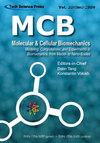On the Image-Based Non-Invasive Diagnosis of Cardiovascular Diseases
Q4 Biochemistry, Genetics and Molecular Biology
引用次数: 0
Abstract
Cardiovascular diseases are the leading cause of human deaths worldwide. Traditional diagnostic tools of cardiovascular diseases are either based on 2D static medical images, or invasive, bringing troubles to both patients and doctors. Our team is committed to the development of image-based non-invasive diagnostic system for cardiovascular diseases. We have made progress mainly in the following areas: 1) 4D flow technology for heart and large blood vessels. According to MRI 4D Flow data, three-dimensional velocity fields within blood vessels were constructed. Divergence-fee smoothing (DFS) was proposed to eliminate the high frequency noise in the hemodynamic flow field, and make the smoothed velocity field to satisfy the divergence-free condition. The vascular wall shear stress, pressure and other physiological indicators were obtained, their accuracy can meet the need of clinical applications. 2) Accurate noninvasive diagnostic techniques for coronary arterial disease. According to coronary CTA imaging data, 3D reconstruction of coronary arteries was achieved coronary stenosis and plaque lesion were identified and analyzed. Coronary microcirculation was modeled using a 0d model; the coronary artery FFR were computed through the Fast FFR technique, which was based on the reduced-order computational fluid dynamics (CFD). The Fast FFR technique can compute the FFR within 5 minutes. Similar techniques have been used in the preoperative evaluation of intraluminal artery bypass. 3) In vitro evaluation of artificial heart valves and blood-contacting artificial organs. High-fidelity CFD and PIV technique were developed to study the flow field in the artificial heart valve and blood pumps. In vitro platform for experimentally and numerically evaluate the blood damage were also developed.基于图像的心血管疾病无创诊断研究
心血管疾病是全世界人类死亡的主要原因。传统的心血管疾病诊断工具要么是基于二维静态医学图像,要么是侵入性的,给患者和医生都带来了麻烦。我们的团队致力于开发基于图像的心血管疾病无创诊断系统。我们主要在以下几个方面取得了进展:1)心脏和大血管的4D血流技术。根据MRI 4D Flow数据,构建血管内三维速度场。为了消除流场中的高频噪声,提出了散度费平滑(DFS)方法,使平滑的速度场满足无散度条件。获得血管壁剪应力、压力等生理指标,其准确性满足临床应用的需要。2)准确的无创冠状动脉疾病诊断技术。根据冠状动脉CTA成像资料,完成冠状动脉三维重建,对冠状动脉狭窄及斑块病变进行识别和分析。冠状动脉微循环模型采用0d模型;采用基于降阶计算流体力学(CFD)的Fast FFR技术计算冠状动脉FFR。快速FFR技术可以在5分钟内计算出FFR。类似的技术已被用于腔内动脉旁路手术的术前评估。3)人工心脏瓣膜和接触血液人工器官的体外评价。采用高保真CFD和PIV技术研究了人工心脏瓣膜和血泵内部的流场。此外,还开发了用于血液损伤实验和数值评估的体外平台。
本文章由计算机程序翻译,如有差异,请以英文原文为准。
求助全文
约1分钟内获得全文
求助全文
来源期刊

Molecular & Cellular Biomechanics
CELL BIOLOGYENGINEERING, BIOMEDICAL&-ENGINEERING, BIOMEDICAL
CiteScore
1.70
自引率
0.00%
发文量
21
期刊介绍:
The field of biomechanics concerns with motion, deformation, and forces in biological systems. With the explosive progress in molecular biology, genomic engineering, bioimaging, and nanotechnology, there will be an ever-increasing generation of knowledge and information concerning the mechanobiology of genes, proteins, cells, tissues, and organs. Such information will bring new diagnostic tools, new therapeutic approaches, and new knowledge on ourselves and our interactions with our environment. It becomes apparent that biomechanics focusing on molecules, cells as well as tissues and organs is an important aspect of modern biomedical sciences. The aims of this journal are to facilitate the studies of the mechanics of biomolecules (including proteins, genes, cytoskeletons, etc.), cells (and their interactions with extracellular matrix), tissues and organs, the development of relevant advanced mathematical methods, and the discovery of biological secrets. As science concerns only with relative truth, we seek ideas that are state-of-the-art, which may be controversial, but stimulate and promote new ideas, new techniques, and new applications.
 求助内容:
求助内容: 应助结果提醒方式:
应助结果提醒方式:


